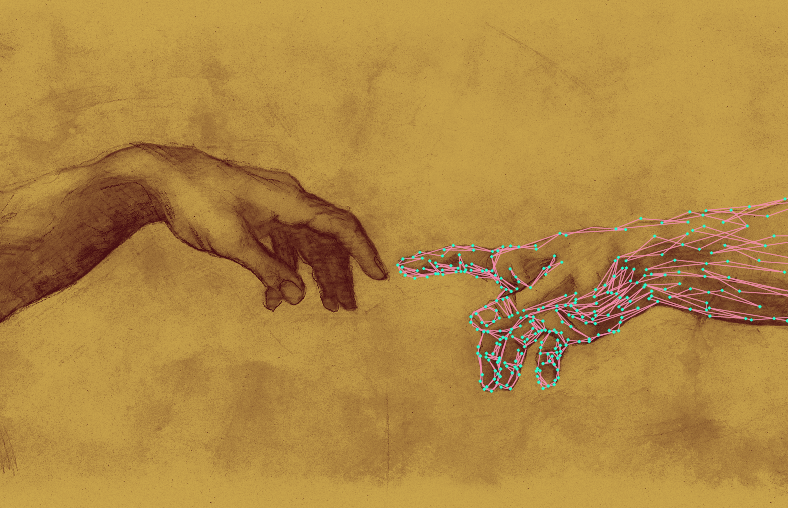Finding the Sweet Spot: How We’re Learning to Dance with AI
A candid look at our ongoing experiment with artificial intelligence in design – and why we think the future is more collaborative than competitive.

We’ll be honest: we’re still figuring this out.
Six months ago, our team started what felt like another one of our experiments: bringing Tavis (you can’t spell Tavis without AI) onto the team, along with his AI tools to integrate in our discovery and design process. Not because we thought robots were going to take over (spoiler alert: they’re not), but because we were curious about what might happen if we approached this technology the same way we approach everything else: with genuine curiosity and a healthy dose of humility. Not just bolting it on, but having it part of our day-to-day way we do things.
What we’ve discovered so far has been pretty refreshing – and maybe a little surprising.
The Reality Check We All Needed
Here’s what the industry data tells us: 87% of agencies are now using AI tools, with efficiency gains averaging 25-40% across design tasks. Even more interesting? 96% report that AI has actually improved their work quality.*
But here’s what those numbers don’t capture – the very human process of learning when to lean in and when to step back.
Where We’ve Found AI Actually Helps (And Where It Definitely Doesn’t)
AI turns out to be remarkably good at the heavy lifting: pattern recognition, rapid iteration, processing massive amounts of data. It can analyze competitor websites faster than any of us can drink our morning coffee and spot trends we might have missed.
What it can’t do? Listen to the pause in a client’s voice when they’re not quite sure how to articulate their vision. Feel the weight of a family business’s 50-year history. Navigate the delicate conversation about why that logo their nephew designed might not be the best fit for their rebrand.
Take a recent project with a luxury rental development. AI helped us analyze dozens of competitive sites, processing everything from interface patterns to search functionality across the waterfront luxury market. The analysis revealed something interesting: while competitors excelled at aspirational branding, they consistently failed at delivering the transparent, real-time search experience today’s renters actually want.
But it was through our own actual experience, and having real conversations with our client and own team – that helped us recognize the deeper frustration: the emotional disconnect between how people want to search (efficiently, transparently, without jumping through hoops) versus how luxury developments typically present themselves (with gatekeeping and vague availability).
The data showed us what competitors were doing. The human conversations showed us what renters actually needed.
How We’re Actually Using This Stuff
We’ve settled into what feels like a pretty natural rhythm:
Discovery stays human: Those deep client conversations, the stakeholder interviews, the strategic positioning work – this is where listening and empathy matter most.
Research gets a boost: AI helps us process market landscapes and consumer insights faster, which means more time for the strategic thinking that actually moves the needle.
Ideation becomes more playful: We set the creative direction and strategic boundaries; AI helps us explore territories we might not have considered. Then we use our judgment to decide what’s genuinely promising versus just algorithmically interesting. Or what might be downright wrong.
Execution gets smarter: AI handles technical optimization and format adaptation, freeing us up for the decisions about hierarchy, emphasis, and emotional impact that really matter.
*Reference: Function Point 2024 Industry Report
The Stuff That’s Still Completely Human
Despite all the impressive AI capabilities, some things remain distinctly ours:
Reading between the lines of a creative brief. Knowing when to push back on feedback that would compromise a brand’s integrity. Understanding how design choices might land differently across communities. Connecting visual decisions to broader business objectives.
And honestly? Just knowing when to break the rules for maximum impact.
What This Actually Means for Your Brand
If you’re thinking about your next brand project, here’s what we’ve learned: the most compelling work happens when technology amplifies human insight rather than replacing it.
We’re not interested in using AI to work faster just for the sake of speed, or to cut corners on the strategic thinking that makes brands actually work. We’re interested in using it so it enables us to spend more time on the conversations, insights, and creative decisions that create genuine connection with your audience.
Still Experimenting, Still Learning
The truth is, we’re still in the early phases of this experiment. We’re learning as we go, staying curious about what’s possible while keeping our feet firmly planted in what we know works: listening carefully, thinking strategically, and creating work that genuinely serves our clients’ goals.
Because at the end of the day, whether we’re using the latest AI tool or a pencil and paper – see Sean’s desk for his collection of written instruments and NEVER forget to put back – the question remains the same: how do we create something that connects with real people in a meaningful way?
Curious about how this approach might work for your next project? We’d love to have a conversation about what’s possible.